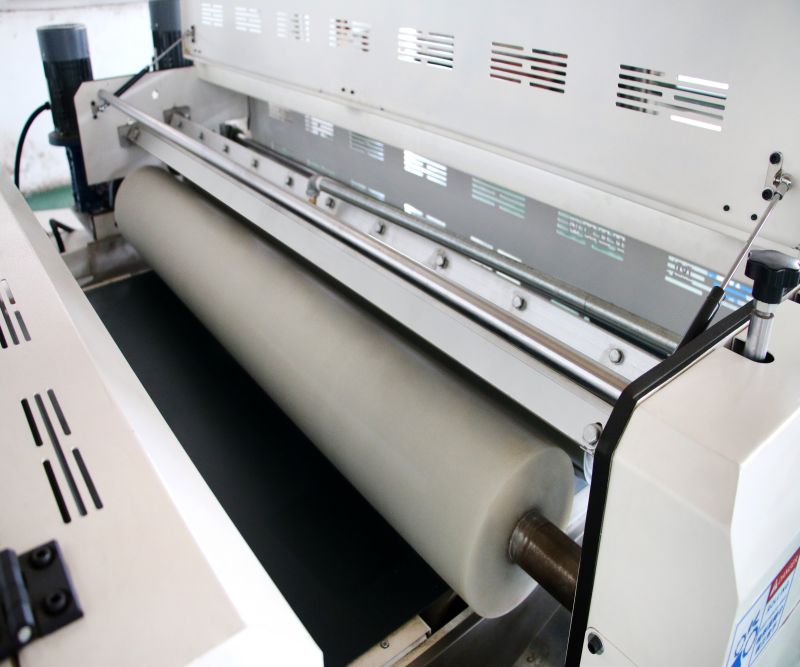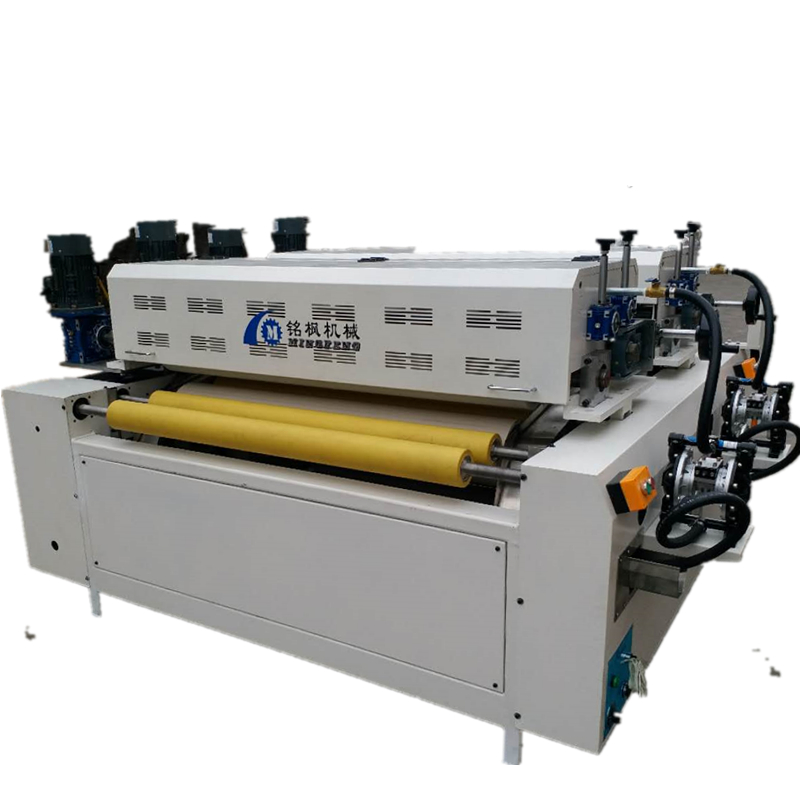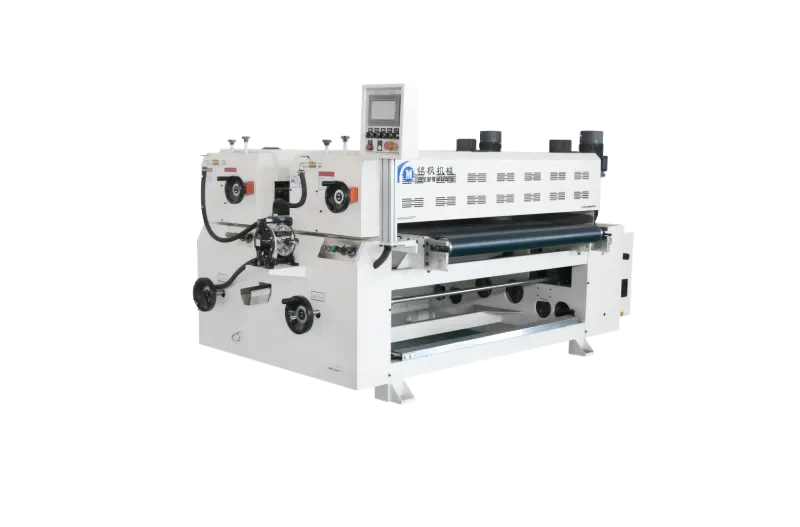A roller coating machine's primary function is to evenly apply coatings to various surfaces using a roller, achieving decorative, protective, or functional effects.
With the advancement of coating materials and rising standards for coating quality, roller coating machines have evolved into various types. Among them, the UV roller coating machine, due to its unique process and performance advantages, has gained widespread application in furniture manufacturing, decorative building materials, and the electronics industry.
This article will focus on the core comparison of the UV roller coating machine vs. other roller coating machines, analyzing the key differences to help readers more fully understand the uniqueness of this specialized equipment.
What is a UV roller coating machine?
A UV roller coating machine is a roller coating machine specifically designed for applying UV-curable coatings. It uses a coating roller to evenly apply UV coating to the substrate surface and rapidly cures the coating using a UV light source. Because UV coatings do not dry at room temperature and require UV light to crosslink and form a film, UV roller coating machines are typically used in conjunction with UV curing machines to form an integrated production system.
What is the definition of other roller coating machines?
Other roller coating machines, as opposed to UV roller coating machines, primarily include equipment that uses traditional solvent-based paints, water-based paints, PU/PE/NC paints, and other non-UV coatings. These machines have similar coating methods, using a coating roller to evenly apply the coating to the surface of the sheet, but their curing methods differ, typically relying on natural drying, hot air drying, or infrared drying.
UV roller coating machine vs. other machines: Differences in coating types
1. UV roller coating machine: Photocuring
UV roller coating machines use UV resin coatings containing photoinitiators. UV light rapidly initiates a polymerization reaction, completing the crosslinking and curing of the coating. The entire film-forming process typically completes within seconds.
Advantages of UV Roller Coating Machines:
· Extremely fast curing speed, saving waiting time
· Dense coating with excellent wear resistance
· Extremely low VOC emissions, excellent environmental performance
2. Other Roller Coating Machines: Evaporative Drying or Heat Drying
Other types of roller coating machines use coatings that primarily form films through the evaporation of solvents or water, or through heat-induced chemical reactions. For example, polyurethane (PU) paint requires a crosslinker reaction, while water-based paint requires heat drying.
Limitations of Other Roller Coating Machines:
· Long drying time and low efficiency
· Solvent-based paints contain VOCs, posing environmental risks
· Film quality is easily affected by factors such as ambient humidity and temperature

UV Roller Coating Machine vs. Other Machines: Differences in Equipment Structure and Configuration
1. Structural Features of UV Roller Coating Machines
In addition to the basic conveyor and coating systems, UV roller coating machines require specialized components such as a UV light source system, cooling system, light leakage prevention mechanism, and a high-precision control system.
Key Features:
· UV light box (high-pressure mercury lamp, LED UV lamp)
· Lampshade temperature control system
· Enclosed protective device to prevent UV leakage
· Integrates with a UV curing unit for in-line operation
2. Structure of Other Roller Coating Machines
Traditional roller coating equipment has a relatively simple structure, often consisting of only:
· Coating roller
· Metering roller
· Conveyor roller
· Heating or ventilation device (depending on the coating type)
The mechanical structure is relatively fixed, making it less flexible than a UV roller coating machine. However, it is easier to operate and has a lower investment cost.

UV Roller Coating Machine vs. Other Machines: Differences in Applicable Substrates
1. UV Roller Coating Machine Applicability
UV roller coating machines are suitable for a variety of substrates, especially those requiring high gloss, wear resistance, and scratch resistance, such as:
· MDF boards
· Melamine veneer panels
· Solid wood veneer panels
· Glass and plastic panels (custom orders)
Suitable Processes:
· High-gloss topcoat, sealer primer
· Paint, transfer primer
· Anti-scratch topcoat
2. Applicability of Other Roller Coating Machines
Non-UV roller coating machines are more suitable for the following applications:
· Mid- and low-end furniture panels
· Primer coating for rough-surfaced panels
· Processes requiring lower requirements or no immediate curing
Although they are applicable to a wide range of materials, they have limitations in high-precision coating, and their film-forming performance is slightly inferior to that of UV systems.
UV Roller Coating Machine vs. Other Machines: Coating Performance Comparison
| Comparison Parameters | UV roller coating machine | Other roller coaters |
Coating Gloss | Extremely high, reaching over 90% | Medium speed, typically between 40 and 80 rpm |
| Abrasion Resistance | Excellent, suitable for high-frequency applications | Generally, requires multiple layers for improved performance |
| Surface Smoothness | High, mirror-like finish | Depending on the coating type, achieving a mirror finish may be difficult |
| Drying Time | Extremely fast, curing in 1-3 seconds | Slow, ranging from several minutes to dozens of minutes |
| Environmental Performance | No VOC emissions | Solvent-based coatings require exhaust purification |
| Yellowing Resistance | Excellent, no discoloration under long-term sunlight | Susceptible to discoloration, requiring the addition of UV-resistant additives |
UV Roller Coating Machine vs. Other Machines: Production Efficiency and Line Compatibility
1. UV Roller Coating Machine
Due to its instant-dry coating feature, the UV roller coating machine significantly improves the cycle time of the entire production line. It is suitable for integration with automatic loading, sanding, printing, laminating, and other equipment to form a highly automated coating line. It is particularly well-suited for medium- to large-volume, continuous production.
2. Other Roller Coating Machines
While traditional coating machines offer advantages in terms of cost-effectiveness and simplified operation, their overall efficiency is limited by factors such as drying time, operator proficiency, and environmental conditions. They are primarily used in small- to medium-volume or customized production scenarios.
UV Roller Coating Machine vs. Other Machines: Environmental Comparison
1. Environmental Characteristics of UV Roller Coating Machines
·No Volatile Organic Solvents (Zero VOC)
·No harmful gases released during the film-forming process
·Complies with environmental regulations such as green manufacturing and EU RoHS standards
·Operator-friendly, providing excellent workshop air quality
2. Environmental Impacts of Other Coating Machines
·Solvent-based coatings contain high levels of VOCs
·The drying process releases harmful gases, requiring the installation of exhaust and purification systems
·Requires reliance on solvent recovery or environmental protection facilities, increasing indirect costs
UV Roller Coating Machine vs. Other Machines: Cost Comparison
Cost Types | UV roller coating machine | Other roller coaters |
| Equipment Purchase Cost | High (including UV lamps, cooling system, photoelectric protection, etc.) | Relatively low |
| Coating Cost | UV coatings are expensive per unit, but the unit usage is low | Coating is inexpensive but requires high volumes |
| Energy Cost | UV lamps consume high power but cure quickly, resulting in low overall energy consumption | Drying equipment requires long operating times, resulting in high overall energy consumption |
| Maintenance Cost | Lamp replacement frequency is high, and the control system is complex | Mainly mechanical components, requiring minimal maintenance |
| Environmental Support Cost | Almost zero | Ventilation and exhaust treatment equipment required |
Overall, UV roller coating machines have a higher initial investment, but offer better long-term operating costs, making them suitable for users seeking high efficiency and quality.
UV Roller Coating Machine vs. Other Machines: Maintenance and Operation Comparison
1. UV Roller Coating Machine
· Regular cleaning of the UV lamp housing and reflector is required
· Lamp lifespan and replacement intervals must be recorded
· The control system includes a PLC program, requiring familiarity with the user interface
· Requires operator training
2. Other Roller Coating Machines
· Simple mechanical structure; daily maintenance primarily involves cleaning and lubrication
· Relatively easy troubleshooting
· Suitable for manual intervention and low-automation applications
Although UV roller coating machines require more specialized maintenance, proper operation and regular maintenance can effectively extend equipment life and ensure coating quality.

How to Choose the Right Coating Equipment?
From the above comparison, we can see that UV roller coating machines excel in coating quality, environmental friendliness, and curing efficiency. They are particularly suitable for industrial applications with high demands on product appearance and performance, such as high-end furniture, decorative building materials, and electronic assembly boards. Other types of roller coating machines, on the other hand, are more suitable for cost-sensitive applications with moderate coating requirements, such as low- and mid-range panels and sealant primers.
When selecting coating equipment, consider the following factors:
1. Product positioning (high-end/conventional)
2. Capacity requirements (continuous/intermittent)
3. Environmental policy constraints
4. Budget and operating costs
5. Operator skill level
Can I request a customized coating solution from XMF Machinery?
Absolutely. As a professional manufacturer and coating equipment supplier, XMF Machinery offers fully customized solutions for your substrate, coating chemistry, and manufacturing process. After an initial assessment, we provide a detailed quote and proposed layout for the machine line configuration. Customers seeking customized equipment benefit from promotions, flexible prices, and bulk discounts.
